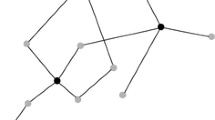Summary
This paper proposes a self-stabilizing protocol which circulates a token on a connected network in nondeterministic depth-first-search order, rooted at a special node. Starting with any initial state in which the network may have no token at all or more than one token, the protocol eventually makes the system stabilize in states having exactly one circulating token. With a slight modification to the protocol —by removing nondeterminism in the search — a depth-first-search tree on the network can be constructed. The proposed protocol runs on systems that allow parallel operations.
Similar content being viewed by others
References
Arora A, Gouda M: Distributed reset (extended abstract). In: Proc 10th Conf Foundation on Software Technology and Theoretical Comput Science. Lect Notes Comput Sci, vol 472. Springer, Berlin Heidelberg New York 1990, pp 316–331
Brown GM, Gouda MG, Wu CL: Token systems that selfstabilize. IEEE Trans Comput 38:845–852 (1989)
Burns JE, Gouda MG, Miller RE: On relaxing interleaving assumptions. In: Proc MCC Workshop on Self-stabilizing Systems, August 1989
Burns JE, Pach J: Uniform self-stabilizing rings. ACM Trans Program Lang Syst 11(2): 330–344 (1989)
Chen NS, Yu HP, Huang ST: A self-stabilizing algorithm for constructing spanning trees. Inf Process Lett 39: 147–151 (1991)
Dijkstra EW: Self-stabilizing systems in spite of distributed control. Commun ACM 17(11): 643–644 (1974)
Dijkstra EW: A belated proof of self-stabilization. Distrib Comput 1:5–6 (1986)
Dolev S, Israeli A, Moran S: Self stabilization of dynamic systems. In: Proc MCC Workshop on Self-stabilizing Systems, August 1989
Gouda M, Multari N: Stabilizing communication protocol. IEEE Trans Comput. 40(4):448–458 (1991)
Huang ST, Chen NS: A self-stabilizing algorithm for constructing bread-first trees. Inf Process Lett 41: 109–117 (1992)
Kruijer HSM: Self-stabilizing (in spite of distributed control) in tree-structured systems. Inf Process Lett 2:91–95 (1979)
Kessels JLW: An exercise in proving self-stabilization with a variant function. Inf Process Lett 29:39–42 (1988)
Lamport L: Solved problems, unsolved problems and nonproblems in concurrency. In: Proc 3rd ACM Symposium on Principles of Distributed Computing, pp 1–11 (1984)
Lakshmanan KB, Meenakshi N, Thulasiraman K: A timeoptimal message-efficient distributed algorithm for depth-first-search. Inf Process Lett 25: 103–109 (1987)
Tarjan RE: Depth-first search and linear graph algorithms. SIAM J Comput 3: 62–89 (1974)
Author information
Authors and Affiliations
Additional information
Shing-Tsaan Huang was born in Taiwan on September 4, 1949. He got his Ph.D. degree in 1985 from Department of Computer Science, University of Maryland at College Park. Before he pursued his Ph.D. degree, he had worked several years in the computer industry in Taiwan. Professor Huang is currently the chairman of the Department of Computer Science, Tsing Hua University, Taiwan, Republic of China. His research interests include interconnection networks, operating systems and distributed computing. He is a senior member of the IEEE Computer Society and a member of the Association for Computing Machinery.
Nian-Shing Chen was born in Taiwan on October 21, 1961. He received his Ph.D. degree in computer science from National Tsing Hua University in 1990. Dr. Chen is currently an associate professor with the Department of Information Management at Sun Yat-Sen University of Taiwan. His research interests include distributed systems, computer networks, computer viruses and expert systems. He is a member of IEEE and Phi Tau Phi honorary society.
This research is supported by National Science Council of the Republic of China under the contract NSC81-0408-E-007-05 and NSC82-0408-E-007-027
Rights and permissions
About this article
Cite this article
Huang, ST., Chen, NS. Self-stabilizing depth-first token circulation on networks. Distrib Comput 7, 61–66 (1993). https://doi.org/10.1007/BF02278857
Received:
Accepted:
Issue Date:
DOI: https://doi.org/10.1007/BF02278857




